Dear Barbara,
It’s not my first time in Bologna, but it’s definitely my most sentimental one. Medieval cities have a substantial impact on me, sometimes adding an unbearable weight on my shoulders. I know that most people love visiting places with cobblestone streets and medieval buildings, but such journeys always result in melancholy for me. The porticos of Bologna -a city also called “La Dotta, La Grassa, La Rossa” (The Learned, The Fat, The Red)-, narrate stories of wealthy families from the dark ages continuously.
But Bologna is different from other medieval cities; it’s not like Tallinn or Prague. That unbearable weight is most of the time absent here. Instead, there is a non-stop life in the streets, and the fact that Bologna is packed with universities and students is a way to dress a dense atmosphere in colorful clothes. The cafes, the bars, the benches: youth declares its presence in every place and proves its dynamic at all times. Youth is more than a biological social element for old cities: it’s a way to release oxygen trapped in century-old walls.
As for me, well, I’m not alone here in Bologna. It’s actually the first journey after a long time that I have some company. I don’t have to walk alone all day long, but I also cannot plan my days without asking. Solo traveling can make you rebellious, but group traveling can make you blissful. But what’s really happening when you’re traveling with your parents?
The Two Towers of Bologna
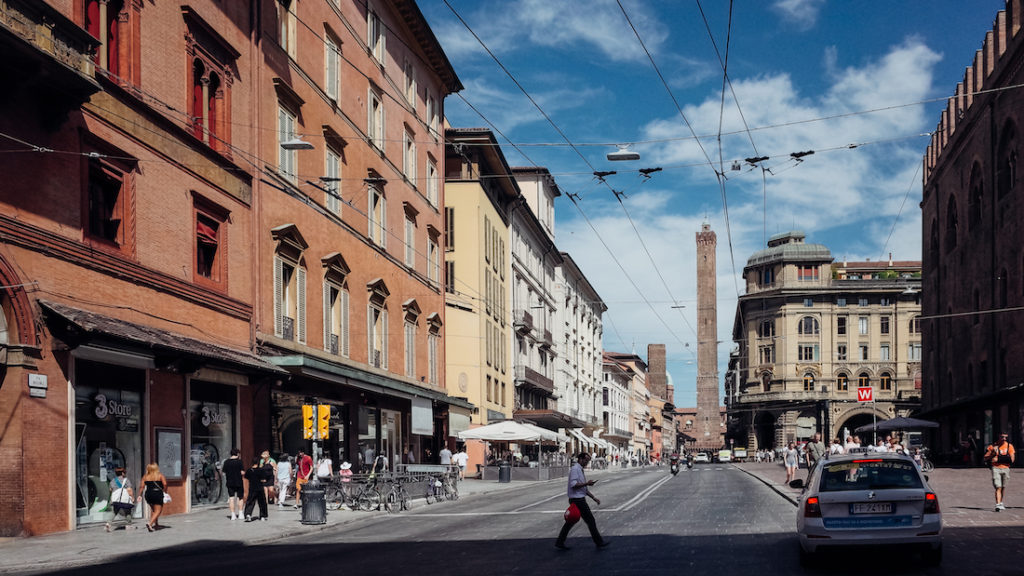
The Two Towers of Bologna (Italian: Le due Torri) is the most prominent landmark of the city. Both are leaning, but this doesn’t affect their pride: they stand in the same place since 1119. Their names come from two powerful families of the era, and they were probably built due to competition: each family thought that it was the most powerful -and they had to prove it.
The Two Towers of Bologna have the names of the two families, of course. The name of the taller one is Asinelli, while the smaller one is called Garisenda. It is possible to climb the Tower of Asinelli, but you’ll have to take 498 steps. I observe the Two Towers of Bologna every single day during my stay, and I see them every time I exit the porticos of Via Ugo Bassi.
I can’t decide if I want to climb the Asinelli Tower, and in the end, the days go by, and I don’t. It’s probably a side-effect of medieval cities: they tend to make me indecisive.
Cinema at Piazza Maggiore
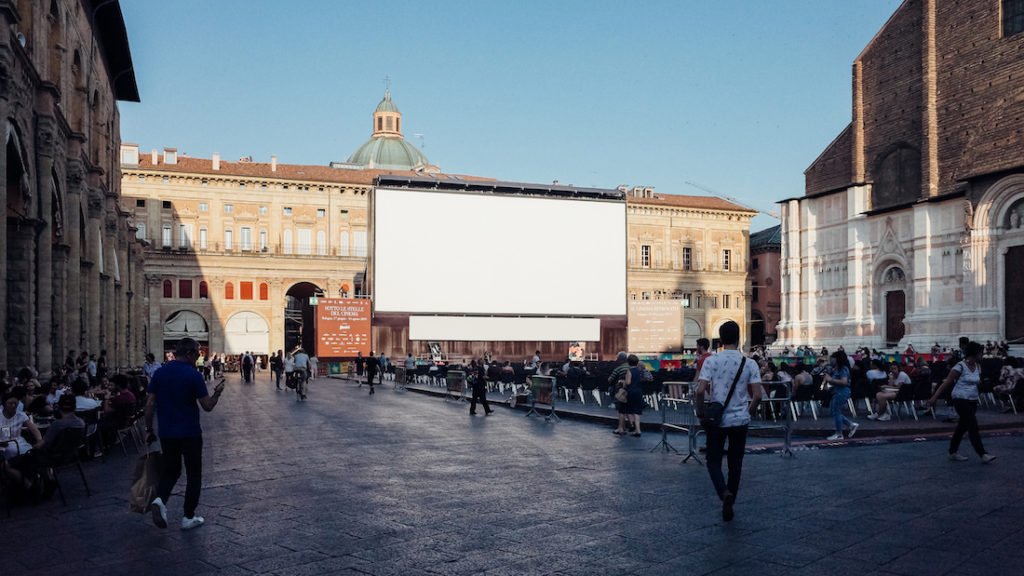
The Piazza Maggiore is the biggest square of Bologna. Everybody comes here to see and be seen -and lately, to shoot a selfie. Architecture is at its finest here: the Palazzo dei Banchi, the Basilica di San Petronio, the Palazzo dei Notai, and the Palazzo d’Accursio are all close to each other. All these impressive buildings are marking the past of Bologna like an indelible seal. They stand, they observe, and they never betray.
But here is how Bologna removes some weight from its past. At night, the Piazza Maggiore transforms into an open-air cinema without an entry ticket. Hundreds of chairs and a huge screen reshape the night. Moving images and fleeting stories appear on the screen, and the square abolishes some of the weight from the Palazzos and the Duomo. A full program of old and contemporary movies makes the warm nights of Bologna pleasant. People are holding their breaths, not due to the architecture, but because of a film on a tender night.
I’m breathing next to a crowd longing for connection, romance, and images on the screen. Youngsters dressed in sloppy clothes, older guys with linen trousers, and girls that walk along the Duomo searching for a place in the Cathedral’s stairs to comfort their naked legs. That crowd, which prefers to smoke instead of drinking alcohol, stares at the screen for two hours. Italian nights are forever.
They stole a tram (1954)
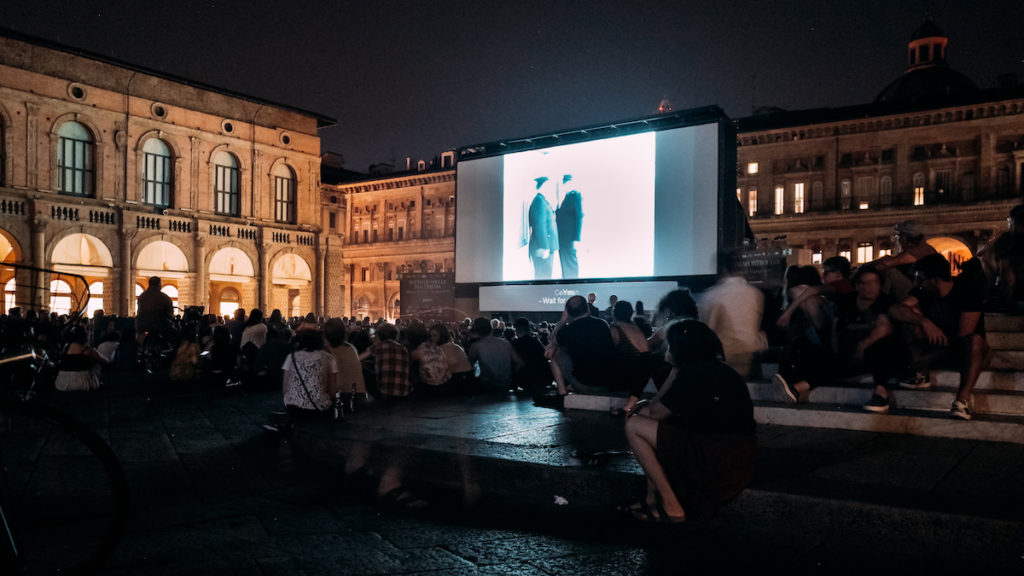
One of the nights there is a movie called “They stole a tram” (Italian: Hanno rubato un tram). It is an old Italian movie of the ’50s by Aldo Fabrizi, and what makes it unique is that it’s entirely shot in Bologna. For 90 minutes, the spectators immerse in the atmosphere of old times: there is a constant dialectic between contemporary Bologna and the 1950s. The movie is funny, and it has a hilarious ending, where the main character steals a tram and roams the foggy streets of Bologna. Behind the lightweight approach of the movie, one can identify the beginning of an era: the optimism of post-war Europe expressed as a triumph of free will.
Shortly after the end, I discover a fun trivia about the movie. While Aldo Fabrizi is the star and main character, the assistant director is a relatively unknown man back then: Sergio Leone.
Finestrella di via Piella
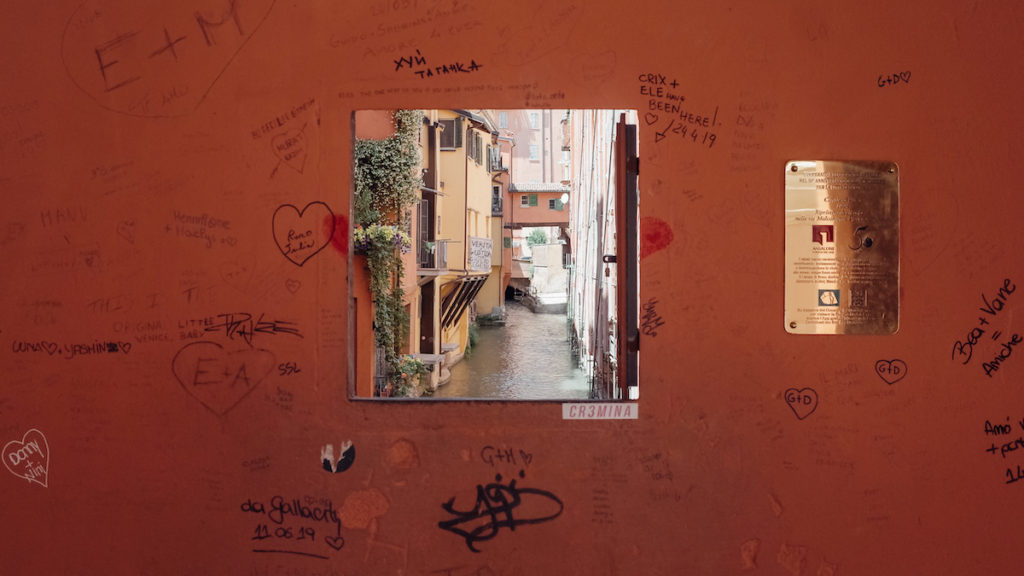
My days in Bologna are slow, and I keep searching for the past. Personal memories forever lost, but also Bologna’s glimpses of a time long gone. And meanwhile, I observe the habits of my parents, and I try to find out who we really are when we are traveling with the people we know for our whole life. That’s how I end up one day in front of the Finestrella di via Piella, attached to a red wall.
Bologna’s walls are painted with a terracotta color that is exceptionally pleasing to the eyes. Having a long tradition in anti-fascist movements, Bologna’s nickname “The Red” is also a tribute to that famous color of the city. In such a wall, I see the Finestrella. This is a small window at via Piella, which offers a rare peek at Bologna’s lost canals.
Back in the 12th century, Bologna was a totally different city. Canals actually surrounded it, and there were even boats transporting goods, from silk to tobacco. But as time went by, the economy redefined its priorities, and the city abolished the canals: roads covered them. Nowadays, there aren’t many spots to observe these old canals, but Finestrella is the best one.
On a terracotta wall close to the city center (it should be less than a kilometer away from the Piazza Maggiore), there is a small window. From there, you can get a glimpse of the canal and see the water flowing. It is a picturesque spot that looks like a stamp from the old times.

The end of childhood in Bologna
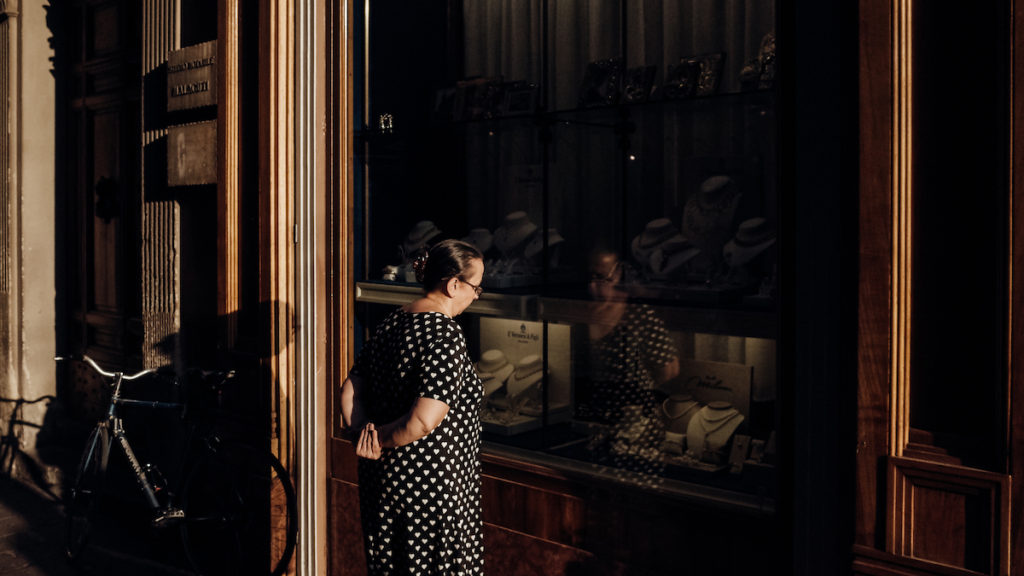
Delicious food, chic academics, and loads of art and political movements. Cobblestone streets, leaning towers, and the longest porticos in the world. Palazzo, Piazza, and Via. Names, movies, and fancy clothes. Heat, aperitivo, and terracotta walls. Everything seems to come in a set of three in Bologna. My father, my mother, and me.
We spend some easy-going days in Bologna. We walk, laugh, drink coffee, and sometimes we argue as a proper Greek family. They need their time in the morning, they have to take a nap in the afternoon, they have to stop for a coffee now and then, they need to eat properly twice per day. And then, at night they want to watch a movie at Piazza Maggiore. They would like to have a drink, and they want to chat until they fall asleep. Their schedule is totally different from mine: I want to walk as much as possible, I can survive with one meal per day, at night I have to write till 3 a.m.
But I decide to follow their schedule. We haven’t been on vacation together for more than 15 years. In historical terms, this is just the blink of an eye, but this is quite a long time for a family. Those 15 years have transformed us a lot: when they were my age, they had a family, they had to take care of my brother and me. Now, as if this is the only way life develops, I have to keep an eye on them.
Aging parents seem to transform into little children. They become stubborn, easily annoyed, and super-scheduled. They have to eat and sleep at a specific time, and when we are on a journey, I’m the one to make the schedule. Of course, they want to see things in Bologna, but they won’t compromise. And this can be stressful. The smallest groups are the hardest to handle.
One night, while watching “Roma” by Alfonso Cuaron at the open-air cinema of Piazza Maggiore, I space out. It’s a black and white movie, and those seem to be the only acceptable colors of memories. It’s a hot night, and I drink a gin tonic. And then, out of nowhere, I think that if you are more than 35 years old and you are wondering if you would like to have kids, there is only one way to decide: to go on vacation with your parents. If you can manage it, you are probably ready.
That day in front of the Finestrella, I see the old canals of Bologna partly and partly my childhood. That’s how I probably remember my childhood: a small window on a terracotta wall with a majestic view. From that short description, the most important word is “small.” It’s something that will always be there, but from the moment you start thinking that you are the one to take care of your parents, it belongs to the past.
I’m tired but happy to be here with them. There is never a real requiem for a childhood; there’s always hope to return in this careless age. Even if this means that you have to be old enough in order to return to the stubbornness of a kid. Bologna, that old parent of Emilia-Romagna, will always be attractive to young men and women. Old cities, exactly like aging parents, are not only important for being capsules of memories. As time goes by, they become luminous lighthouses.
Best regards from us all,
George
More about Italy: A travelogue from Catania, The stories of Florence, Majestic Syracuse, Florence facts
*Get my FREE Travel Writing Course*
Pin it for later
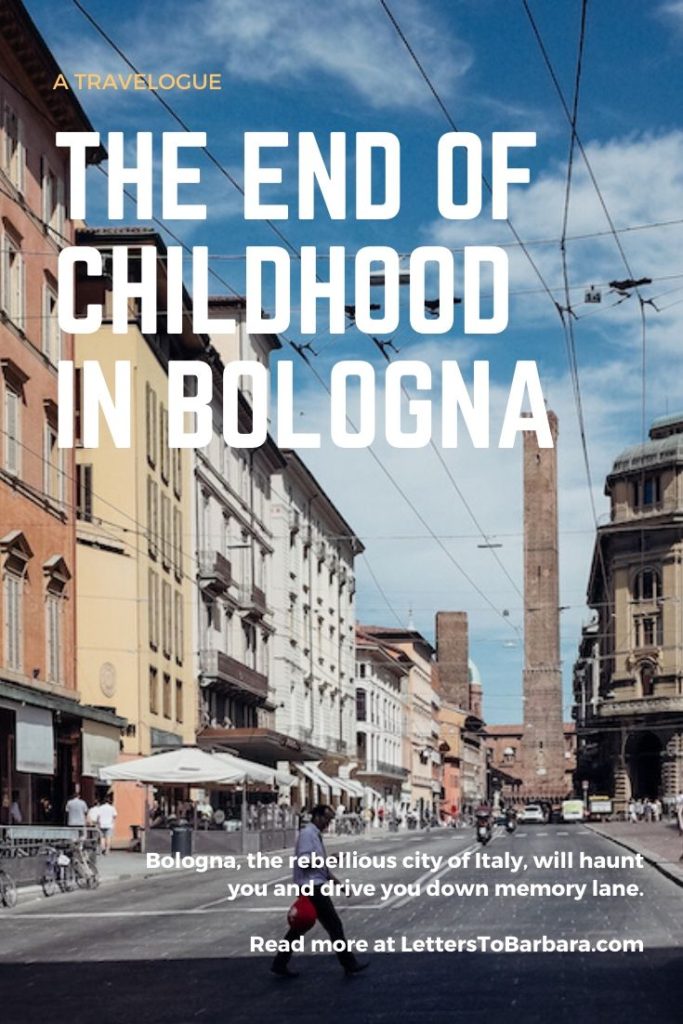
Please share, tweet, and pin if you enjoyed reading The end of childhood in Bologna. Your support keeps this website running and all the info up-to-date. 🙂
Last Updated on September 4, 2021 by George Pavlopoulos

Hi George, I have to say that Bologna has never been on my holiday radar before but after reading this post I’d really like to visit Balogna one day. The food is supposed to be fantastic even by Italian standards from what I’ve since read about the city. To have shared your experience there in this magical city with your parents would have been very special. I’ve done a similar sort of thing later in life and it was very memorable. One of the big attractions in Bologna is the fountain of Neptune, located in the eponymous square, Piazza del Nettuno, next to Piazza Maggiore. Incredibly Neptune’s trident at this very spot was used by the Maserati family as a model for their luxury vehicle logo. I hope you took a photo of Neptune (Poseidon). It would be great to see it in this post if you do have one as would a family photo, or one of your parents together in Bologna. It will make the post even more interesting. All the best, John
Hey John. Bologna is stunning. I have a photo of the fountain of Neptune, but I saved it for a future post about the city. I might consider adding a photo in this post as well -thanks for mentioning it. Regarding my parents, they loved the city, and I do have a couple of photos of them. But I think they are a bit Internet-shy at the moment, so I’ll have to convince them 🙂 The food is excellent in Bologna, and the Italian Aperitivos will probably make you drunk in no time. Italy is one of my favorite countries in Europe (if not the favorite), and Bologna is a gem. I can only recommend a visit to the city after the situation eases up a bit.
Take care,
George